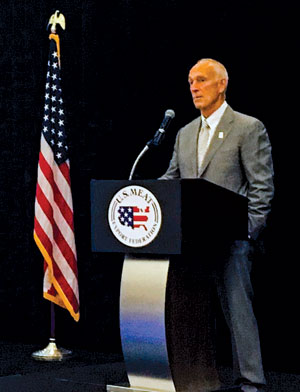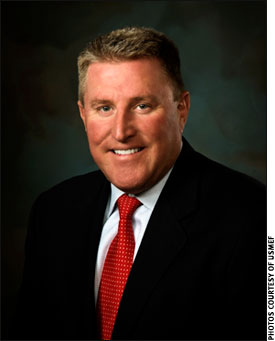USMEF President Retires
USMEF kicks off spring conference, announces succession plan.

USMEF President and CEO Philip Seng discussed the current global trade environment.
The U.S. Meat Export Federation (USMEF) opened its spring conference May 24 in Arlington, Va., with an extensive discussion of the current international trade environment and a review of year-to-date export results for U.S. pork, beef and lamb. The federation also announced the successor to longtime USMEF President and CEO Philip Seng. Dan Halstrom, USMEF senior vice president for marketing, will become president Sept. 1 and assume the title of president and CEO Dec. 1. Seng will remain with the organization as CEO emeritus through July 2018.
USMEF Chairman Bruce Schmoll, a soybean and corn producer from Claremont, Minn., welcomed members to the spring conference and recapped strong first-quarter results for U.S. red meat exports. Schmoll noted that Mexico is a terrific destination for U.S. pork, and USMEF’s new product development and consumer education efforts continue to bolster per capita pork consumption in Mexico.
U.S. beef exports to Mexico are also trending upward in 2017, but the main drivers of beef export growth in the first quarter were the mainstay Asian markets of Japan, South Korea and Taiwan. Schmoll said home meal replacement is a rapidly growing segment in Asia, especially in Korea.
Schmoll discussed the recent decision by Costco–Korea to convert the chilled beef meatcases at all 15 of its locations to 100% U.S. beef.
“With Costco being such a respected trend-setter for Korean consumers and other Korean retailers, the long-term, positive impact for U.S. beef will reach well beyond the walls of these Costco warehouses,” he said.
Schmoll said the USDA Market Access Program (MAP) and the Foreign Market Development (FMD) Program are important tools that contribute to the success U.S. red meat is achieving in the global marketplace. He urged USMEF members to voice their support for these programs, which were targeted for elimination in the Trump administration’s fiscal year 2018 budget proposal released earlier in the week.
“This is only the first step in a long budget process, and there is strong bipartisan support on Capitol Hill for MAP and FMD,” Schmoll explained.
Trade updates and policies
Seng offered a historical perspective on red meat trade with Japan, explaining the impressive gains made in this market despite significant trade barriers. He noted that Japan has imported $62 billion in U.S. beef and pork during the past 30 years, despite a temporary closure of the market to U.S. beef due to bovine spongiform encephalopathy (BSE), and an even longer period in which U.S. exports to Japan were restricted to beef from cattle less than 21 months of age.
Seng cautioned that the United States may be underestimating the importance of constructive relationships with key trading partners, citing Mexico as an example of a country that is actively seeking alternative food suppliers.
“For the past 70 years, the hallmark of our agricultural trade policy with countries that can’t be self-sufficient in food production has been, ‘You don’t have to be self-sufficient, but you can be food secure with the United States as your partner,’ ” Seng said. “When we start talking about playing by a different set of rules, these countries look to diversify. And as Mexico begins to look south, they’ll find that they can source pork and beef from different suppliers, and that’s a very important development.”
Political insights
USMEF’s guest speaker was Stuart Rothenberg, a long-time Washington, D.C., political analyst who is senior editor at Inside Elections. He served for more than two decades as editor and publisher of The Rothenberg Political Report, a nonpartisan political newsletter covering U.S. House, Senate and gubernatorial campaigns and presidential politics. He also was a columnist for Roll Call and The Washington Post.
Rothenberg spent much of his presentation on the struggles of the Trump administration to establish meaningful policy direction, with the investigation into the Trump administration’s possible ties to Russia and several other distractions coming at a bad time for a brand new presidency.
“President Trump is going to deal with health care and tax reform and infrastructure and budget spending priorities — while all this other stuff is going on?” Rothenberg asked. “Well, he’s going to have to, but you can see how much more difficult it will be. In Washington, it’s difficult to get things through during good times.”
Rothenberg expressed frustration with national media, which he said tend to examine every poll as if it were going to somehow demonstrate a dramatic turn in public opinion.
“The president has only been in office for a little over four months,” Rothenberg said. “In another four months, six months, eight months — some of his supporters may start to take the criticism more seriously.”
New USMEF president
To close the session, USMEF past chairman Roel Andriessen, who chaired the search committee charged with finding and recommending candidates for the position of USMEF president, explained the extensive process that led the committee to identify Halstrom as its leading candidate. Andriessen also paid tribute to Seng for his decades of service to the organization, which Seng joined as Asia director in 1982 — just six years after USMEF was founded.
“Phil, on behalf of the USMEF Executive Committee and USMEF members and staff, we applaud your leadership and vision for this industry, which started a long time ago,” Andriessen said. “You are a legend in our industry — there’s no doubt about that, and your shoes will be extremely difficult to fill. You will leave behind a great legacy, and I want to applaud you for all you have done for us.”

Dan Halstrom will become USMEF president Sept. 1.
Halstrom echoed these sentiments, noting that he’s learned a wealth of information from Seng — not only during his time with USMEF, but throughout his 34-year career in international meat trade.
“I certainly don’t expect to replace Phil Seng, but I hope to complement him with the help of a very talented USMEF team, and that is a tremendous advantage going forward,” he said. “Many people are aware of Phil’s long career with USMEF, and I’ve learned a great deal from him in the time I’ve been involved with the organization. But we also have staff members in key markets such as Hong Kong, Korea and Japan who have been with USMEF for a very long time. They are truly grounded in the meat business, and they are in these markets every day building demand for U.S. meat products and monitoring our competition. I look forward to being even more involved with this group and drawing upon their knowledge and experience.”
Halstrom joined USMEF as senior vice president for marketing in 2010, overseeing promotional activities for U.S. red meat managed through the organization’s 18 international offices. He was previously vice president for international sales with JBS S.A., where he managed global beef and pork sales. From 1990 through 1999, Halstrom directed international pork sales for Swift/ConAgra Foods Inc. A native of northwest Iowa and a graduate of the University of Iowa, Halstrom currently resides in Fort Collins, Colo.
Editor’s Note: This article is from USMEF.







